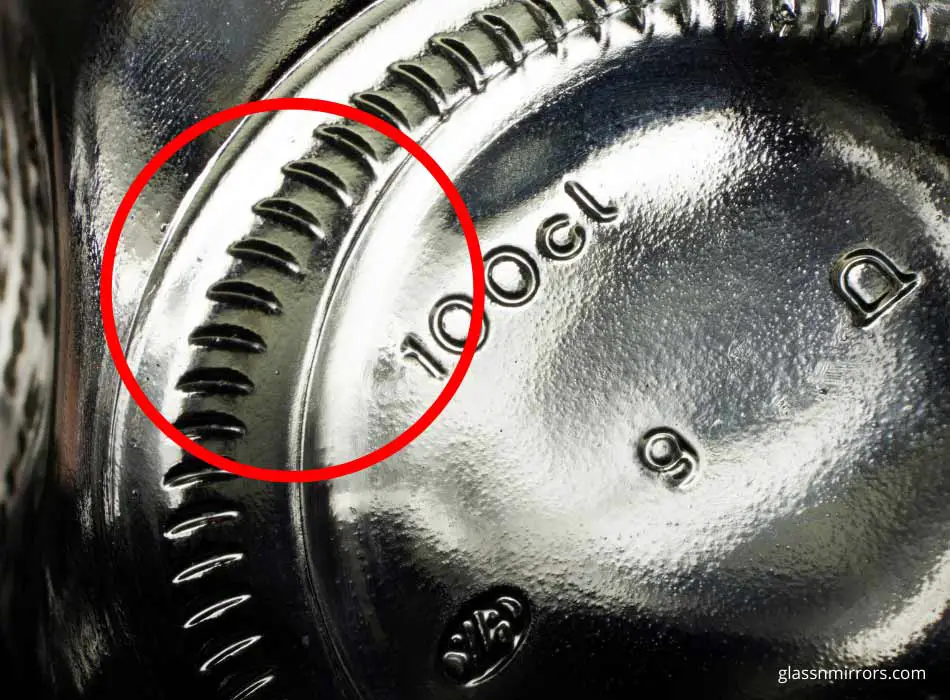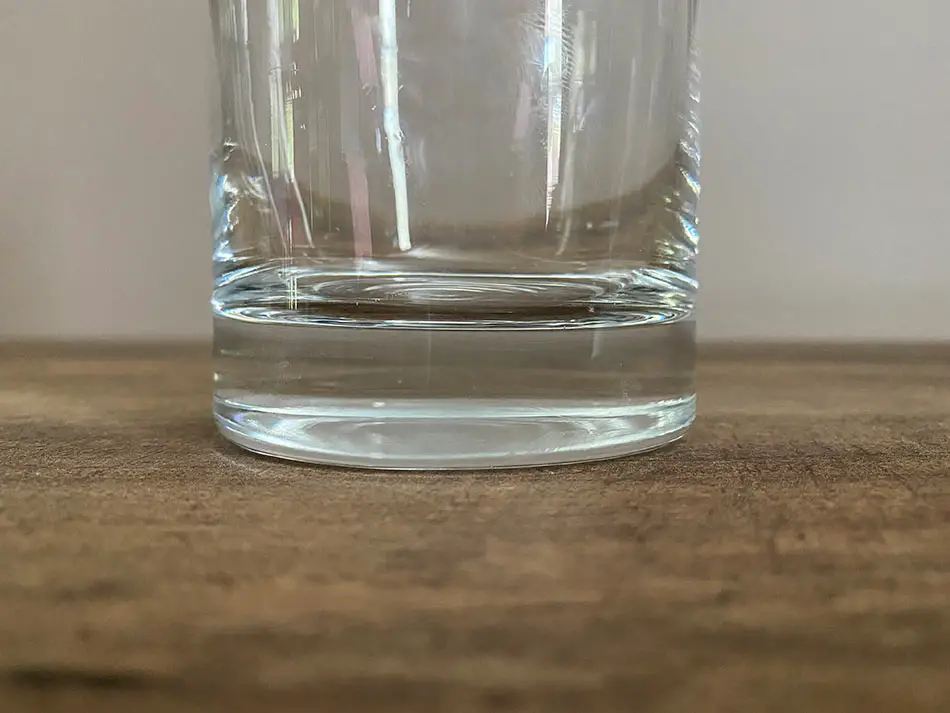If you’ve ever held a glass bottle and felt its base, you might have noticed two things. First, the base of the bottle is slightly curved inwards, and second that the edges of the bottle’s base have numerous tiny ridges.
Glass bottled have ridges on the bottom to prevent a vacuum when condensation occurs at the base of the bottle. When water vapor turns to liquid, it occupies less space. The ridges raise the bottle, so more air enters, preventing a vacuum and protecting the surface on which the bottle is placed.
In this article, you will learn more about the 4 key reasons most glass bottles have ridges. By the end, you will understand that the ridges are far more than a quirk and serve multiple functional purposes. You will also find out why glasses and cups have a raised base, which is tangentially related to bottle ridges. Let’s get started with the reason glass bottles have ridges on the bottom.

Table of Contents
- 1 Prevents Bottom Vacuum
- 2 It Prevents a Layer of Water From Forming Under The Bottle
- 3 Anti-slip Measure
- 4 Part of the Standard Mold
- 5 Why Do Cups And Glasses Have a Raised Base?
- 6 Final Thoughts – Why Do Glass Bottles Have Ridges On Them?
- 7 What Is Panda Glass | Ultimate Guide To Panda Glass
- 8 Can Heat Break Glass? Temperature & Fracturing Explained
- 9 Why Is Glass Polar? – Glass Polarity Explained!
Prevents Bottom Vacuum
Glass bottles don’t usually contain hot liquids because glass itself is a super-cooled liquid. Exposure to heat can distort a glass. With that in mind, we can assume that glass bottles are meant for cold drinks. Given that air contains H2O, which cools down to become water, liquid droplets can form on cold water bottles.
These are appetizing in hot weather but also make the bottle harder to grip and difficult to handle. While condensation on the sides of a glass bottle can be a plus and is somewhat manageable, the same at the base of the bottle can be risky. Hold any glass bottle and try to feel its base. In most cases, the bottom will not be flat and will have a slight inward curve. This acute angle helps the bottle stand firmly.
However, if condensation occurs at the bottom of a glass bottle with an inward curve, a vacuum forms. Hot water vapor in the air condenses as it interacts with glass that’s chilled because of the cold drink.
As a result, the vapor becomes liquid, which means it occupies less space and creates a vacuum in the process. A bottle with a significantly acute base would stick to the table if it didn’t have ridges. The ridges allow air to come under the bottle when condensation creates a gap.
This is why glass cutting boards have feet on them.
It Prevents a Layer of Water From Forming Under The Bottle
As mentioned earlier, most bottles have an inward bend at the base. However, some bottles have a flat base. Usually, old refillable bottles and jars are flat at the bottom aside from the ridges. These containers aren’t at risk of a bottom vacuum since there is no space for said vacuum.
However, condensation can still cause trouble as a layer of water forms immediately under cool glass. Without ridges, such bottles would slip in a puddle of water they create. Ridges not only lift the bottles to the point where small droplets do not create a slipping hazard, but they create room for condensed droplets to move away from the bottle.
Anti-slip Measure
The third reason behind ridges on glass bottles’ bottom is surface area. Are you more stable on one foot, or are you better balanced on two? The answer is two. The more appendages touch the ground, the better grip you have.
When you go on all fours, you have an even better hold though you sacrifice mobility and functionality, which is why we primarily locomote on two legs. But if you find yourself on a trampoline or shaky grounds, you would want to get on all fours for stability.
The bottle version of getting on all fours is having a few dozen ridges that all make contact with the surface beneath the bottle. This doesn’t mean the bottle cannot be knocked over. It just offsets the inherent advantage that glass containers have of slipping because of condensation on the table surface.
Part of the Standard Mold
Glass bottles aren’t made one unit at a time. Almost no handicraft goes into making standard glass bottles that are blown into form inside a mold. That’s why all bottles of a certain size used by a brand are identical. One reason bottles have ridges is that bottle molds often come with room for ridges.
Bigger businesses own their bottling operations, whereas smaller ones use a back-end bottle manufacturer. Either way, the bottles are made using molds that have room for ridges. When glass is blown into shape, the ridges form as a consequence of this space. Reasons behind ridges being added to standard glass bottle mold are explained above.
Why Do Cups And Glasses Have a Raised Base?
As mentioned earlier, there is an acute gap between the center of a glass bottle’s base and the flat surface it sits on. The same applies to glasses and cups as well. Very rarely will you see a cup that sits flat without being raised to some extent. Consumer convenience is the rationale behind this.
Glasses and cups have a raised base to regulate beverage temperature. A hot cup’s base can burn the tabletop, while a cold glass with a thin, flat base absorbs heat from the furniture. As a result, the drink it holds can get warm quicker than it can be consumed.

Hot cups with a raised base do not need anti-condensation measures because water vapor doesn’t liquefy upon getting in touch with the cup base. A glass base is colder and can condense water vapor in the air to form droplets of water. But because there are ridges that can allow more air to enter the space, no vacuum is created.
Final Thoughts – Why Do Glass Bottles Have Ridges On Them?
Glass bottle ridges serve multiple purposes that all add up to consumer convenience and damage prevention. The condensation that occurs beneath cold bottles can lead to the bottle breaking in half because of vacuum suction. The ridges raise the bottle and prevent a vacuum.
Here’s a recap of the functions of glass bottle ridges.
- Ridges make the bottle more stable.
- Glass bottles don’t get stuck when raised by ridges
- Ridges are a part of the standardized bottle mold
- Ridges keep the table surface from becoming wet.
-
What Is Panda Glass | Ultimate Guide To Panda Glass

When looking for a new phone case, you may have encountered the term “panda glass.” A variety of phone cases on the market use this type of glass. But what … Keep Reading
-
Can Heat Break Glass? Temperature & Fracturing Explained

Even though technology has improved, you may have heard of a glass door suddenly breaking with a loud pop and a smashing sound. There have been many reports of windows … Keep Reading
-
Why Is Glass Polar? – Glass Polarity Explained!

You may have heard the term “polar” used when discussing glass. But what does that mean? And why is glass polar in the first place? The difference between the electronegativity … Keep Reading

2 thoughts on “Here’s Why Glass Bottles Have Ridges On The Bottom”
Comments are closed.